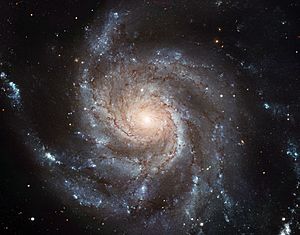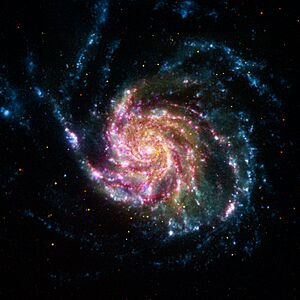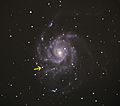Pinwheel galaxy facts for kids


The Pinwheel Galaxy is a huge, beautiful spiral galaxy that we can see face-on. It's also known as Messier 101 (or M101) and NGC 5457. You can find it in the constellation of Ursa Major, which means "Great Bear."
This amazing galaxy is about 21 million light-years away from Earth. That's a super long distance! A French astronomer named Pierre Méchain first spotted it on March 27, 1781. Later, Charles Messier checked its location and added it to his famous Messier catalogue. It was one of the last objects he added to his list.
In 2006, NASA and the ESA shared a very detailed picture of the Pinwheel Galaxy. At the time, it was the biggest and clearest image of a galaxy ever taken by the Hubble Space Telescope. This incredible picture was made by combining 51 separate photos, plus some extra ones taken from Earth.
Contents
What Makes the Pinwheel Galaxy Special?
The Pinwheel Galaxy has some really cool features that make it stand out.
Supernova Explosion in M101
On August 24, 2011, a huge star explosion called a supernova happened in M101. This type of supernova is called SN 2011fe. It was a very bright event that scientists could study.
Bright Star-Forming Regions
One of the most amazing things about the Pinwheel Galaxy is its huge and super bright H II regions. Scientists have counted about 3,000 of these regions in pictures like the Hubble image.
H II regions are like cosmic nurseries where new stars are born. They are full of dense clouds of hydrogen gas. Inside these clouds, many young, massive, and very blue stars form. These young stars give off a lot of ultraviolet light. This light makes the gas around them glow brightly, which is why we can see these regions so clearly.
The Black Hole in M101
The Pinwheel Galaxy also has something called ULX-1. This stands for "ultra-luminous X-ray source." It's a relatively small black hole, but it's still very powerful. This black hole is about 20 to 30 times heavier than our Sun.
Images for kids
-
Dark sky image with some objects around Pinwheel Galaxy (M 101). The quarter in the lower right shows the tail of Ursa Major with the stars Mizar, Alcor and Alkaid.
See also
 In Spanish: Galaxia espiral M101 para niños
In Spanish: Galaxia espiral M101 para niños




